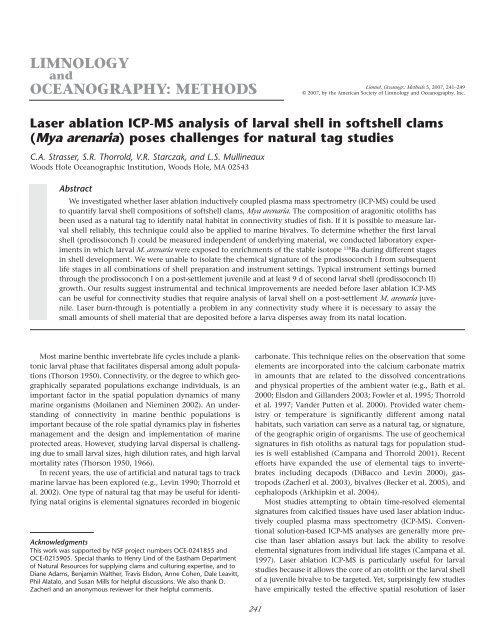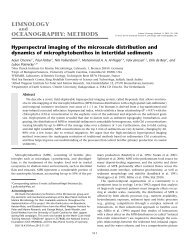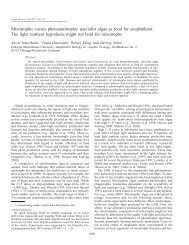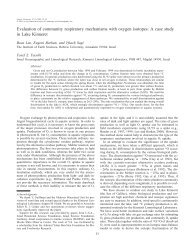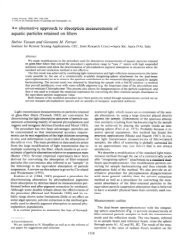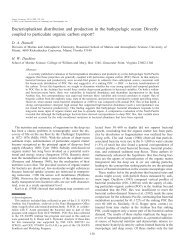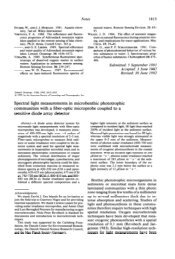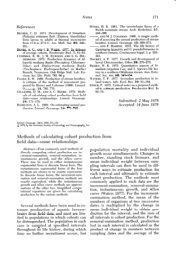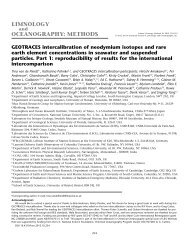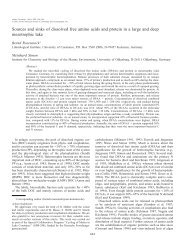Laser ablation ICP-MS analysis of larval shell in softshell clams
Laser ablation ICP-MS analysis of larval shell in softshell clams
Laser ablation ICP-MS analysis of larval shell in softshell clams
You also want an ePaper? Increase the reach of your titles
YUMPU automatically turns print PDFs into web optimized ePapers that Google loves.
LIMNOLOGY<br />
and<br />
OCEANOGRAPHY: METHODS<br />
<strong>Laser</strong> <strong>ablation</strong> <strong>ICP</strong>-<strong>MS</strong> <strong>analysis</strong> <strong>of</strong> <strong>larval</strong> <strong>shell</strong> <strong>in</strong> s<strong>of</strong>t<strong>shell</strong> <strong>clams</strong><br />
(Mya arenaria) poses challenges for natural tag studies<br />
C.A. Strasser, S.R. Thorrold, V.R. Starczak, and L.S. Mull<strong>in</strong>eaux<br />
Woods Hole Oceanographic Institution, Woods Hole, MA 02543<br />
Abstract<br />
We <strong>in</strong>vestigated whether laser <strong>ablation</strong> <strong>in</strong>ductively coupled plasma mass spectrometry (<strong>ICP</strong>-<strong>MS</strong>) could be used<br />
to quantify <strong>larval</strong> <strong>shell</strong> compositions <strong>of</strong> s<strong>of</strong>t<strong>shell</strong> <strong>clams</strong>, Mya arenaria. The composition <strong>of</strong> aragonitic otoliths has<br />
been used as a natural tag to identify natal habitat <strong>in</strong> connectivity studies <strong>of</strong> fish. If it is possible to measure <strong>larval</strong><br />
<strong>shell</strong> reliably, this technique could also be applied to mar<strong>in</strong>e bivalves. To determ<strong>in</strong>e whether the first <strong>larval</strong><br />
<strong>shell</strong> (prodissoconch I) could be measured <strong>in</strong>dependent <strong>of</strong> underly<strong>in</strong>g material, we conducted laboratory experiments<br />
<strong>in</strong> which <strong>larval</strong> M. arenaria were exposed to enrichments <strong>of</strong> the stable isotope 138 Ba dur<strong>in</strong>g different stages<br />
<strong>in</strong> <strong>shell</strong> development. We were unable to isolate the chemical signature <strong>of</strong> the prodissoconch I from subsequent<br />
life stages <strong>in</strong> all comb<strong>in</strong>ations <strong>of</strong> <strong>shell</strong> preparation and <strong>in</strong>strument sett<strong>in</strong>gs. Typical <strong>in</strong>strument sett<strong>in</strong>gs burned<br />
through the prodissoconch I on a post-settlement juvenile and at least 9 d <strong>of</strong> second <strong>larval</strong> <strong>shell</strong> (prodissoconch II)<br />
growth. Our results suggest <strong>in</strong>strumental and technical improvements are needed before laser <strong>ablation</strong> <strong>ICP</strong>-<strong>MS</strong><br />
can be useful for connectivity studies that require <strong>analysis</strong> <strong>of</strong> <strong>larval</strong> <strong>shell</strong> on a post-settlement M. arenaria juvenile.<br />
<strong>Laser</strong> burn-through is potentially a problem <strong>in</strong> any connectivity study where it is necessary to assay the<br />
small amounts <strong>of</strong> <strong>shell</strong> material that are deposited before a larva disperses away from its natal location.<br />
Most mar<strong>in</strong>e benthic <strong>in</strong>vertebrate life cycles <strong>in</strong>clude a planktonic<br />
<strong>larval</strong> phase that facilitates dispersal among adult populations<br />
(Thorson 1950). Connectivity, or the degree to which geographically<br />
separated populations exchange <strong>in</strong>dividuals, is an<br />
important factor <strong>in</strong> the spatial population dynamics <strong>of</strong> many<br />
mar<strong>in</strong>e organisms (Moilanen and Niem<strong>in</strong>en 2002). An understand<strong>in</strong>g<br />
<strong>of</strong> connectivity <strong>in</strong> mar<strong>in</strong>e benthic populations is<br />
important because <strong>of</strong> the role spatial dynamics play <strong>in</strong> fisheries<br />
management and the design and implementation <strong>of</strong> mar<strong>in</strong>e<br />
protected areas. However, study<strong>in</strong>g <strong>larval</strong> dispersal is challeng<strong>in</strong>g<br />
due to small <strong>larval</strong> sizes, high dilution rates, and high <strong>larval</strong><br />
mortality rates (Thorson 1950, 1966).<br />
In recent years, the use <strong>of</strong> artificial and natural tags to track<br />
mar<strong>in</strong>e larvae has been explored (e.g., Lev<strong>in</strong> 1990; Thorrold et<br />
al. 2002). One type <strong>of</strong> natural tag that may be useful for identify<strong>in</strong>g<br />
natal orig<strong>in</strong>s is elemental signatures recorded <strong>in</strong> biogenic<br />
Acknowledgments<br />
This work was supported by NSF project numbers OCE-0241855 and<br />
OCE-0215905. Special thanks to Henry L<strong>in</strong>d <strong>of</strong> the Eastham Department<br />
<strong>of</strong> Natural Resources for supply<strong>in</strong>g <strong>clams</strong> and cultur<strong>in</strong>g expertise, and to<br />
Diane Adams, Benjam<strong>in</strong> Walther, Travis Elsdon, Anne Cohen, Dale Leavitt,<br />
Phil Alatalo, and Susan Mills for helpful discussions. We also thank D.<br />
Zacherl and an anonymous reviewer for their helpful comments.<br />
carbonate. This technique relies on the observation that some<br />
elements are <strong>in</strong>corporated <strong>in</strong>to the calcium carbonate matrix<br />
<strong>in</strong> amounts that are related to the dissolved concentrations<br />
and physical properties <strong>of</strong> the ambient water (e.g., Bath et al.<br />
2000; Elsdon and Gillanders 2003; Fowler et al. 1995; Thorrold<br />
et al. 1997; Vander Putten et al. 2000). Provided water chemistry<br />
or temperature is significantly different among natal<br />
habitats, such variation can serve as a natural tag, or signature,<br />
<strong>of</strong> the geographic orig<strong>in</strong> <strong>of</strong> organisms. The use <strong>of</strong> geochemical<br />
signatures <strong>in</strong> fish otoliths as natural tags for population studies<br />
is well established (Campana and Thorrold 2001). Recent<br />
efforts have expanded the use <strong>of</strong> elemental tags to <strong>in</strong>vertebrates<br />
<strong>in</strong>clud<strong>in</strong>g decapods (DiBacco and Lev<strong>in</strong> 2000), gastropods<br />
(Zacherl et al. 2003), bivalves (Becker et al. 2005), and<br />
cephalopods (Arkhipk<strong>in</strong> et al. 2004).<br />
Most studies attempt<strong>in</strong>g to obta<strong>in</strong> time-resolved elemental<br />
signatures from calcified tissues have used laser <strong>ablation</strong> <strong>in</strong>ductively<br />
coupled plasma mass spectrometry (<strong>ICP</strong>-<strong>MS</strong>). Conventional<br />
solution-based <strong>ICP</strong>-<strong>MS</strong> analyses are generally more precise<br />
than laser <strong>ablation</strong> assays but lack the ability to resolve<br />
elemental signatures from <strong>in</strong>dividual life stages (Campana et al.<br />
1997). <strong>Laser</strong> <strong>ablation</strong> <strong>ICP</strong>-<strong>MS</strong> is particularly useful for <strong>larval</strong><br />
studies because it allows the core <strong>of</strong> an otolith or the <strong>larval</strong> <strong>shell</strong><br />
<strong>of</strong> a juvenile bivalve to be targeted. Yet, surpris<strong>in</strong>gly few studies<br />
have empirically tested the effective spatial resolution <strong>of</strong> laser<br />
241<br />
Limnol. Oceanogr.: Methods 5, 2007, 241–249<br />
© 2007, by the American Society <strong>of</strong> Limnology and Oceanography, Inc.
Strasser et al. LA-<strong>ICP</strong>-<strong>MS</strong> burns through <strong>larval</strong> <strong>shell</strong><br />
Fig. 1. Shell development <strong>in</strong> M. arenaria. PI and PII <strong>larval</strong> <strong>shell</strong>s are<br />
underla<strong>in</strong> by juvenile and, ultimately, adult <strong>shell</strong>.<br />
<strong>ablation</strong> <strong>ICP</strong>-<strong>MS</strong>. The goal <strong>of</strong> this study was to determ<strong>in</strong>e if<br />
techniques that have proven successful <strong>in</strong> otolith studies were<br />
also useful for quantify<strong>in</strong>g <strong>larval</strong> dispersal <strong>of</strong> the s<strong>of</strong>t<strong>shell</strong> clam,<br />
Mya arenaria. Specifically, we tested if it was possible to isolate<br />
and measure the early <strong>larval</strong> <strong>shell</strong> (prodissoconch I) <strong>of</strong> M. arenaria<br />
us<strong>in</strong>g laser <strong>ablation</strong> <strong>ICP</strong>-<strong>MS</strong> without contam<strong>in</strong>ation from<br />
underly<strong>in</strong>g late <strong>larval</strong> and juvenile <strong>shell</strong> material. This study is<br />
an important step <strong>in</strong> develop<strong>in</strong>g the use <strong>of</strong> elemental signatures<br />
<strong>in</strong> mollusc <strong>shell</strong>s as tags <strong>of</strong> natal habitat because isolation <strong>of</strong> the<br />
early <strong>larval</strong> <strong>shell</strong> is critical for connectivity studies.<br />
Materials and procedures<br />
Study species—Adult M. arenaria broadcast spawn their<br />
gametes <strong>in</strong>to the water, where fertilized eggs develop <strong>in</strong>to<br />
non-feed<strong>in</strong>g <strong>shell</strong>-less trochophore larvae. With<strong>in</strong> 24 h <strong>of</strong><br />
spawn<strong>in</strong>g, the trochophore metamorphoses <strong>in</strong>to a veliger and<br />
lays down its first <strong>larval</strong> <strong>shell</strong>, the prodissoconch I (hereafter PI),<br />
which is approximately 90 μm <strong>in</strong> diameter (Loosan<strong>of</strong>f et al.<br />
1966). After form<strong>in</strong>g the PI, the veliger beg<strong>in</strong>s feed<strong>in</strong>g <strong>in</strong> the<br />
plankton. Over the next 1 to 3 weeks, it lays down the second<br />
<strong>larval</strong> <strong>shell</strong>, the prodissoconch II (hereafter PII), which grows<br />
to diameters <strong>of</strong> 150 to 200 μm (Loosan<strong>of</strong>f et al. 1966). The<br />
veliger then f<strong>in</strong>ds suitable habitat, settles to the bottom, and<br />
metamorphoses <strong>in</strong>to a juvenile M. arenaria. Juvenile and,<br />
eventually, adult <strong>shell</strong> is laid underneath <strong>larval</strong> <strong>shell</strong>, extend<strong>in</strong>g<br />
away from the umbo (Fig. 1). Larval <strong>shell</strong>s are reta<strong>in</strong>ed dur<strong>in</strong>g<br />
clam growth and development, and the PI can be identified<br />
easily on newly settled juveniles. Estimated water<br />
retention times for typical New England estuaries are 2 days to<br />
a week (Assel<strong>in</strong> and Spauld<strong>in</strong>g 1993; Brooks et al. 1999; Sheldon<br />
and Alber 2002). If larvae are essentially passive particles,<br />
then they are also reta<strong>in</strong>ed <strong>in</strong> estuaries for 2 days to a week<br />
after spawn<strong>in</strong>g, which would be sufficient for the PI <strong>larval</strong><br />
<strong>shell</strong> to form before potential dispersal occurs. If the composition<br />
<strong>of</strong> the <strong>larval</strong> <strong>shell</strong> on a juvenile M. arenaria can be measured<br />
accurately, we may be able to answer questions about<br />
<strong>larval</strong> retention and dispersal.<br />
Clam rear<strong>in</strong>g—M. arenaria veligers were obta<strong>in</strong>ed from the<br />
Eastham Hatchery Facility <strong>in</strong> Eastham, Massachusetts, with<strong>in</strong><br />
6 h <strong>of</strong> spawn<strong>in</strong>g and transported to Woods Hole, Massachusetts.<br />
242<br />
Fig. 2. Location <strong>of</strong> the 138 Ba spike treatments relative to <strong>shell</strong> development.<br />
Shaded regions show areas <strong>of</strong> spiked <strong>shell</strong>.<br />
Approximately 400,000 <strong>in</strong>dividuals were divided <strong>in</strong>to n<strong>in</strong>e<br />
identical covered 10 L tanks. Tanks were filled with 20°C filtered<br />
seawater (sal<strong>in</strong>ity ≈ 32). Assum<strong>in</strong>g roughly 10% mortality<br />
dur<strong>in</strong>g transport from Eastham to Woods Hole, <strong>in</strong>itial <strong>larval</strong><br />
counts were approximately 40,000 per tank. Each tank was<br />
randomly assigned one <strong>of</strong> three treatments described below,<br />
with three replicate tanks per treatment.<br />
Several larvae were subsampled from each tank after 48 h,<br />
and the PI was present <strong>in</strong> all sampled larvae. We then exposed<br />
<strong>clams</strong> to one <strong>of</strong> three treatment conditions that differed <strong>in</strong> the<br />
tim<strong>in</strong>g <strong>of</strong> exposure to the stable isotope 138 Ba (Fig. 2). Tanks <strong>in</strong><br />
the first treatment received no 138 Ba spike and therefore the<br />
water had a natural 138 Ba: 137 Ba ratio (“Unspiked”). Tanks <strong>in</strong> the<br />
second treatment received a 138 Ba spike <strong>of</strong> 25 μg g –1 at day 2,<br />
immediately after the PI had set (“Early Spike”). Tanks <strong>in</strong> the<br />
third treatment received a 138 Ba spike <strong>of</strong> 25 μg g –1 at day 9, 7 d<br />
after the PI set (“Late Spike”). By day 9, most <strong>of</strong> the larvae<br />
appeared to have set the PII and become competent to settle<br />
based on their <strong>shell</strong> size, tendency to accumulate at the bottom<br />
<strong>of</strong> the tank, and use <strong>of</strong> their foot for locomotion. This is faster<br />
than the estimated two to three weeks residence time <strong>of</strong> M. arenaria<br />
veligers <strong>in</strong> the field. Laboratory <strong>clams</strong> typically grow and<br />
mature faster compared with those <strong>in</strong> the field because <strong>of</strong> optimized<br />
rear<strong>in</strong>g conditions (H. L<strong>in</strong>d, pers. comm.).<br />
Larvae swam freely <strong>in</strong> tanks for the first 10 d, after which<br />
time they were conta<strong>in</strong>ed <strong>in</strong> mesh sieves suspended <strong>in</strong> the<br />
tanks. Water pumps were used to create a downward current<br />
that encouraged larvae to settle out <strong>of</strong> the water column. Subsampl<strong>in</strong>g<br />
<strong>of</strong> tanks <strong>in</strong>dicated that larvae metamorphosed<br />
with<strong>in</strong> 2 to 3 d after downwell<strong>in</strong>g began. Clams were fed<br />
Isochrysis sp. and Pavlova sp. algae at least once every 2 d, and<br />
the water <strong>in</strong> each tank was changed every 2 d. In the Early and<br />
Late Spike tanks, a 138 Ba spike concentration <strong>of</strong> 25 μg.g –1 was<br />
ma<strong>in</strong>ta<strong>in</strong>ed for the duration <strong>of</strong> the experiment by add<strong>in</strong>g 138 Ba<br />
immediately after each water change. After 60 d, <strong>clams</strong> ranged<br />
<strong>in</strong> size from 0.5 mm to 5 mm. They were removed from their<br />
tanks and frozen until prepared for <strong>ICP</strong>-<strong>MS</strong> <strong>analysis</strong>. Mortality
Strasser et al. LA-<strong>ICP</strong>-<strong>MS</strong> burns through <strong>larval</strong> <strong>shell</strong><br />
rates were high <strong>in</strong> all tanks, and seven <strong>of</strong> the n<strong>in</strong>e tanks had<br />
survivors: three replicate tanks from the Unspiked treatment<br />
(n = 35, n = 33, n = 7), two replicate tanks from Early Spike<br />
treatment (n = 75, n = 22), and two replicate tanks from the<br />
Late Spike treatment (n = 14, n = 8).<br />
Shell preparation—Shells were cleaned thoroughly us<strong>in</strong>g<br />
techniques developed for foram<strong>in</strong>iferan tests (Boyle 1981)<br />
with modifications specifically for M. arenaria. Clams were<br />
placed <strong>in</strong> <strong>in</strong>dividual acid-washed vials us<strong>in</strong>g acid-washed plastic<br />
forceps, and sonicated briefly to remove tissue and debris.<br />
Individuals were r<strong>in</strong>sed three times with ultrapure H 2 O, then<br />
soaked for 10 m<strong>in</strong> at 80°C <strong>in</strong> 1% H 2 O 2 solution buffered with<br />
suprapur NaOH (1 N) to remove organic material. Afterward,<br />
<strong>shell</strong>s were r<strong>in</strong>sed three times with ultrapure H 2 O, transferred<br />
to clean, acid-washed vials, r<strong>in</strong>sed four times with ultrapure<br />
H 2 O, then left to dry overnight under a lam<strong>in</strong>ar flow hood.<br />
Shells were <strong>in</strong>spected after clean<strong>in</strong>g and dry<strong>in</strong>g for any<br />
rema<strong>in</strong><strong>in</strong>g organic material; dried tissue was removed <strong>in</strong> the<br />
few cases where it was present.<br />
Shells were mounted for laser <strong>ablation</strong> <strong>ICP</strong>-<strong>MS</strong> <strong>analysis</strong> on<br />
glass slides us<strong>in</strong>g Devcon© Super Glue. One valve <strong>of</strong> each clam<br />
was oriented so that the reta<strong>in</strong>ed <strong>larval</strong> <strong>shell</strong> was accessible by<br />
the laser (i.e., umbo fac<strong>in</strong>g upward), while the second valve<br />
was oriented concave side down so that the laser could access<br />
the flattest portion <strong>of</strong> the juvenile <strong>shell</strong>. All clean<strong>in</strong>g and<br />
preparations were conducted <strong>in</strong> a Class 100 clean room.<br />
<strong>Laser</strong> <strong>ablation</strong> <strong>ICP</strong>-<strong>MS</strong> <strong>analysis</strong>—Shell material was analyzed<br />
us<strong>in</strong>g a Thermo-Electron Element2 <strong>ICP</strong>-<strong>MS</strong> coupled to a New<br />
Wave Research 213 nm laser <strong>ablation</strong> system. Vaporized material<br />
from the <strong>ablation</strong> was transported via a helium gas stream<br />
to the dual-<strong>in</strong>let quartz spray chamber where it was mixed<br />
with a 2% HNO 3 aerosol from a self-aspirat<strong>in</strong>g PFA 20 μL m<strong>in</strong> –1<br />
nebulizer. The analyte was then transported to the <strong>ICP</strong>-<strong>MS</strong> via<br />
an argon carrier gas. An aragonite otolith reference material<br />
dissolved <strong>in</strong> 2% HNO 3 and diluted to a Ca concentration <strong>of</strong><br />
40 μg g –1 (Yosh<strong>in</strong>aga et al. 2000) and a 2% HNO 3 blank solution<br />
were run periodically to correct for mass bias drift. We<br />
measured 48 Ca, 138 Ba, and 137 Ba <strong>in</strong> low resolution mode. Isotope<br />
ratios <strong>of</strong> 138 Ba to 137 Ba were calculated us<strong>in</strong>g mass bias correction<br />
calculated from calibration standards that we assumed<br />
conta<strong>in</strong>ed natural 138 Ba: 137 Ba ratios. Blank <strong>in</strong>tensity averages<br />
and standard deviations were calculated for each <strong>of</strong> the three<br />
<strong>analysis</strong> periods (Oct 2005, Jan 2006, Feb 2006). Limits <strong>of</strong><br />
detection (LOD) were calculated as the ratio <strong>of</strong> three standard<br />
deviations <strong>of</strong> the blank <strong>in</strong>tensity to the average blank-subtracted<br />
sample <strong>in</strong>tensity. For the three time periods over<br />
which samples were analyzed, sample <strong>in</strong>tensities were > 100,<br />
> 690, and > 2800 times the detection limit for 48 Ca; > 100,<br />
> 30, and > 20 times the detection limit for 137 Ba; and > 290,<br />
> 127, and > 30 times the detection limit for 138 Ba, respectively.<br />
Measurements were taken from two positions on each<br />
clam: one on the <strong>larval</strong> <strong>shell</strong> at the umbo, and a second on<br />
juvenile <strong>shell</strong> material 600 μm away from the umbo (umbo<br />
and juvenile measurements, respectively). Shell composition<br />
Table 1. <strong>Laser</strong> <strong>ablation</strong> <strong>ICP</strong>-<strong>MS</strong> sett<strong>in</strong>gs used to analyze<br />
M. arenaria <strong>shell</strong><br />
for each clam was analyzed us<strong>in</strong>g one <strong>of</strong> two laser sett<strong>in</strong>gs<br />
(Table 1). In the first case (Raster Sett<strong>in</strong>g), the laser removed<br />
<strong>shell</strong> material systematically from a 70 μm × 70 μm square<br />
raster pattern. Instrument and laser sett<strong>in</strong>gs were chosen to<br />
ma<strong>in</strong>ta<strong>in</strong> 48 Ca counts above two million counts s –1 . For the<br />
second sett<strong>in</strong>g (Spot Sett<strong>in</strong>g), the laser was focused on a s<strong>in</strong>gle<br />
spot with a beam diameter <strong>of</strong> 80 μm, and laser energy was<br />
reduced to 50% power. The laser pulsed on the spot repeatedly,<br />
bor<strong>in</strong>g down <strong>in</strong>to <strong>shell</strong> material. Therefore, at least the<br />
first few seconds <strong>of</strong> measurement at the umbo should reflect<br />
<strong>larval</strong> <strong>shell</strong>; afterward the laser was expected to penetrate<br />
underly<strong>in</strong>g material. This sett<strong>in</strong>g was used to explore whether<br />
the composition <strong>of</strong> th<strong>in</strong> <strong>larval</strong> <strong>shell</strong> could be quantified at<br />
reduced laser power with m<strong>in</strong>imal material removed (i.e., only<br />
a few seconds <strong>of</strong> material <strong>ablation</strong>).<br />
Rationale for experimental setup—Umbo and juvenile <strong>shell</strong><br />
were each measured on <strong>clams</strong> from the three Unspiked treatment<br />
tanks (n = 13, n = 9, n = 6) to test whether uptake differed<br />
between umbo and juvenile areas <strong>of</strong> the <strong>shell</strong>. No statistically<br />
significant differences were found for the three tanks<br />
comb<strong>in</strong>ed (paired t test, t = 0.83, n = 28, P = 0.42) so only<br />
umbo measurements were used to simplify <strong>analysis</strong>.<br />
Shell ratios <strong>of</strong> 138 Ba: 137 Ba were expected to fall <strong>in</strong>to one <strong>of</strong><br />
three categories: a natural ratio, a fully 138 Ba-spiked elevated<br />
ratio, or somewhere between these two end members. The<br />
natural ratio was determ<strong>in</strong>ed by measur<strong>in</strong>g <strong>shell</strong> that was not<br />
spiked (i.e., <strong>clams</strong> from the Unspiked treatment). The fully<br />
spiked ratio was determ<strong>in</strong>ed for each clam <strong>in</strong>dividually <strong>in</strong> the<br />
Early and Late Spike treatments by measur<strong>in</strong>g juvenile <strong>shell</strong>.<br />
Umbo measurements <strong>of</strong> <strong>clams</strong> from Early Spike and Late Spike<br />
treatments were expected to show one <strong>of</strong> three results,<br />
depend<strong>in</strong>g on the depth <strong>of</strong> laser penetration (Fig. 3): (A) no<br />
laser burn-through: umbo measurements from Early and Late<br />
Spike treatments did not significantly differ from unspiked<br />
<strong>shell</strong>; (B) some laser burn-through: umbo measurements from<br />
the Early Spike treatment have a significantly higher ratio<br />
than unspiked <strong>shell</strong>; umbo measurements from the Late Spike<br />
treatment have a ratio that does not differ significantly from<br />
unspiked <strong>shell</strong>; (C) extensive laser burn-through: umbo measurements<br />
from Early and Late Spike treatment have ratios<br />
that do not differ significantly from spiked juvenile <strong>shell</strong>.<br />
If laser burn-through does occur, we may be able to correct<br />
for it by subtract<strong>in</strong>g out the signal from any underly<strong>in</strong>g<br />
243<br />
Raster sett<strong>in</strong>g Spot sett<strong>in</strong>g<br />
<strong>Laser</strong> pattern 70 μm2 raster 80 μm spot<br />
<strong>Laser</strong> power 80% 50%<br />
Beam size 25 μm 80 μm<br />
Repetition rate 10 Hz 5 Hz<br />
Scan speed 12 μm s –1<br />
L<strong>in</strong>e spac<strong>in</strong>g 10 μm
Strasser et al. LA-<strong>ICP</strong>-<strong>MS</strong> burns through <strong>larval</strong> <strong>shell</strong><br />
Fig. 3. Three possible scenarios for extent <strong>of</strong> laser burn-through. Graphs<br />
are the expected 138 Ba: 137 Ba ratios for umbo measurements from the three<br />
treatments, depend<strong>in</strong>g on depth <strong>of</strong> laser penetration: (A) no laser burnthrough,<br />
(B) some laser burn-through, and (C) extensive laser burnthrough.<br />
Shaded regions <strong>of</strong> the <strong>shell</strong> graphics <strong>in</strong>dicate spiked material.<br />
The shaded horizontal l<strong>in</strong>e <strong>in</strong> each graph at Expected 138 Ba: 137 Ba ~20<br />
shows fully spiked <strong>shell</strong>, while the l<strong>in</strong>e at Expected 138 Ba: 137 Ba ~6 shows<br />
the natural 138 Ba: 137 Ba ratio.<br />
<strong>shell</strong> that might be contam<strong>in</strong>at<strong>in</strong>g our results. To determ<strong>in</strong>e<br />
if this was possible, we used a simple mix<strong>in</strong>g equation (Eq. 1)<br />
to calculate the proportion <strong>of</strong> spiked and unspiked material<br />
ablated for each clam’s umbo measurement from the spiked<br />
treatments:<br />
138<br />
138<br />
⎛ Ba ⎞<br />
Ba<br />
X ⎜<br />
1 X<br />
(1)<br />
137<br />
137<br />
⎝ Ba<br />
⎟ + ( )<br />
⎠<br />
Ba<br />
⎛ ⎞<br />
- ⎜ ⎟ =<br />
⎝ ⎠<br />
⎛ 138<br />
Ba ⎞<br />
⎜ 137 ⎟<br />
⎝ Ba⎠<br />
Spiked<br />
Unspiked Umbo<br />
where X is the proportion <strong>of</strong> spiked versus unspiked material<br />
ablated from the umbo <strong>of</strong> the clam, ( 138 Ba: 137 Ba) Spiked is the<br />
ratio from the juvenile measurement <strong>of</strong> the clam,<br />
( 138 Ba: 137 Ba) Unspiked is the average ratio from umbos <strong>of</strong> <strong>clams</strong> <strong>in</strong><br />
the Unspiked treatment, and ( 138 Ba: 137 Ba) Umbo is the ratio from<br />
244<br />
the umbo measurement. Equation 1 was rearranged to determ<strong>in</strong>e<br />
the proportion <strong>of</strong> spiked material for each clam:<br />
⎡ ⎛<br />
⎢<br />
⎝<br />
⎜<br />
⎢<br />
X = ⎢<br />
⎛<br />
⎢<br />
⎢⎝<br />
⎜<br />
⎣<br />
138<br />
137<br />
138<br />
137<br />
Ba ⎞<br />
Ba⎠<br />
⎟<br />
Ba ⎞<br />
Ba⎠<br />
⎟<br />
⎛<br />
-<br />
⎝<br />
⎜<br />
Ba ⎞<br />
Ba⎠<br />
⎟<br />
137<br />
Umbo Unspiked<br />
Spiked<br />
Edit<strong>in</strong>g pr<strong>of</strong>iles from Spot Sett<strong>in</strong>g—The Spot Sett<strong>in</strong>g was used<br />
to determ<strong>in</strong>e if unspiked material could be detected by produc<strong>in</strong>g<br />
a Ba isotope depth pr<strong>of</strong>ile centered on the PI position<br />
<strong>of</strong> the <strong>shell</strong>. Data were <strong>in</strong>itially acquired from a 2% HNO 3<br />
blank solution, with laser <strong>ablation</strong> beg<strong>in</strong>n<strong>in</strong>g approximately<br />
18 s <strong>in</strong>to data collection. The result<strong>in</strong>g <strong>in</strong>tensity pr<strong>of</strong>iles were<br />
edited as follows to determ<strong>in</strong>e blank <strong>in</strong>tensities and <strong>shell</strong><br />
material <strong>in</strong>tensities for the three isotopes <strong>of</strong> <strong>in</strong>terest. Blank<br />
values were calculated as the average <strong>of</strong> the first 18 s <strong>of</strong> <strong>analysis</strong>.<br />
We started collect<strong>in</strong>g data for <strong>shell</strong> material once a data<br />
po<strong>in</strong>t was 50% higher <strong>in</strong> 48 Ca <strong>in</strong>tensity than its predecessor for<br />
a total <strong>of</strong> 20 s. Detection limits were then calculated for the<br />
three isotopes based on the blank <strong>in</strong>tensities, and only data<br />
with <strong>in</strong>tensities at least 20% above the detection limit for all<br />
three isotopes were <strong>in</strong>cluded <strong>in</strong> analyses (Fig. 4). The criterion<br />
used to remove data below the detection limit resulted <strong>in</strong><br />
some pr<strong>of</strong>ile sequences be<strong>in</strong>g shorter than others; time pr<strong>of</strong>iles<br />
ranged from 9 to 20 data po<strong>in</strong>ts.<br />
Assessment<br />
Differences between treatments—Us<strong>in</strong>g the Raster Sett<strong>in</strong>g, the<br />
average (± SD) 138Ba: 137Ba ratio <strong>in</strong> <strong>shell</strong> material was 6.4 ± 1.0 for<br />
Unspiked umbo (n = 19), 20.3 ± 6.1 for Early Spike umbo (n = 12),<br />
and 15.5 ± 2.3 for Late Spike umbo (n = 11) (Fig. 5). Us<strong>in</strong>g the<br />
Spot Sett<strong>in</strong>g, the average (± SD) ratio was 5.8 ± 1.1 for unspiked<br />
umbo (n = 8), 20.0 ± 1.9 for Early Spike umbo (n = 14), and 15.5<br />
± 3.9 for Late Spike umbo (n = 3). To determ<strong>in</strong>e if laser burnthrough<br />
occurred, we first tested whether there was significant<br />
variation <strong>in</strong> mean umbo measurements among treatments and<br />
among tanks with<strong>in</strong> treatments us<strong>in</strong>g a mixed model nested<br />
ANOVA (Table 2). Under both Raster and Spot Sett<strong>in</strong>gs, mean<br />
umbo measurements were significantly different between the<br />
three treatments (Raster, F = 56.4, P < 0.0001; Spot, F = 72.5,<br />
2,35 2,23<br />
P < 0.0001), with Unspiked ratio < Late Spike < Early Spike<br />
(Tukey-Kramer Test). We found no significant differences among<br />
tanks with<strong>in</strong> treatments for the raster sett<strong>in</strong>g (P = 0.88; number<br />
<strong>of</strong> <strong>clams</strong> per replicate tank: n = 7, n = 6, n = 6 for Unspiked; n = 6,<br />
n = 6 for Early Spike; n = 6, n = 5 for Late Spike). We were not<br />
able to test for differences among tanks with<strong>in</strong> treatments for the<br />
spot sett<strong>in</strong>g due to <strong>in</strong>sufficient numbers (number <strong>of</strong> samples: n<br />
= 5, n = 3 for Unspiked; n = 14 for Early Spike; n = 3 for Late<br />
Spike). Hereafter measurements from tanks <strong>of</strong> the same treatment<br />
were pooled. Because both Early and Late Spike umbo<br />
ratios differed significantly from Unspiked umbo, we rejected<br />
laser burn-through scenarios A and B and concluded that extensive<br />
laser burn-through was occurr<strong>in</strong>g (Fig. 3C).<br />
138<br />
138 ⎛ Ba ⎞<br />
- 137<br />
⎝<br />
⎜<br />
Ba<br />
⎟<br />
⎠<br />
Unspiked<br />
⎤<br />
⎥<br />
⎥<br />
⎥.<br />
⎥<br />
⎥<br />
⎦<br />
(2)
Strasser et al. LA-<strong>ICP</strong>-<strong>MS</strong> burns through <strong>larval</strong> <strong>shell</strong><br />
Fig. 4. Representative unedited <strong>in</strong>tensity pr<strong>of</strong>iles for <strong>in</strong>dividual <strong>clams</strong> from laser <strong>ablation</strong>-<strong>ICP</strong>-<strong>MS</strong> measurements us<strong>in</strong>g the Spot Sett<strong>in</strong>g for (A) 48 Ca and (B)<br />
138 Ba. The data <strong>in</strong> the first shaded region were used to calculate the blank levels, and the data <strong>in</strong> the second shaded region were excluded from <strong>analysis</strong>.<br />
Ratios for <strong>in</strong>dividual <strong>clams</strong>—The extent <strong>of</strong> laser burn-through<br />
was addressed by compar<strong>in</strong>g umbo measurements with spiked<br />
juvenile <strong>shell</strong> for each clam us<strong>in</strong>g a paired t test. If the umbo<br />
ratio was not significantly different from spiked juvenile <strong>shell</strong>,<br />
it suggests that a measurable quantity <strong>of</strong> unspiked <strong>shell</strong> was not<br />
present at the umbo. For the Raster Sett<strong>in</strong>g, umbo measurements<br />
were not significantly different from juvenile measurements<br />
<strong>in</strong> Unspiked <strong>clams</strong> (t = –0.45, n = 19, P = 0.66) or<br />
Early Spike <strong>clams</strong> (t = –1.0, n = 12, P = 0.34). In Late Spike<br />
<strong>clams</strong>, the umbo 138 Ba: 137 Ba ratio <strong>of</strong> 15.6 was slightly lower<br />
than the juvenile <strong>shell</strong> ratio <strong>of</strong> 18.3 (t = 2.7, n = 11, P < 0.05).<br />
Results were similar us<strong>in</strong>g the Spot Sett<strong>in</strong>g. Unspiked and Early<br />
Spike umbo means were not significantly different from juvenile<br />
measurements (t = 1.6, n = 9, P = 0.15; and t = 0.85, n = 14,<br />
P = 0.41, respectively), whereas Late Spike mean umbo and<br />
juvenile ratios differed, although sample size was small (t = –7.0,<br />
n = 3, P < 0.05). The umbo and juvenile ratios are plotted for<br />
each clam from the Raster Sett<strong>in</strong>g (Fig. 6). Results were similar<br />
for Spot Sett<strong>in</strong>g analyses and are not presented. The data were<br />
aga<strong>in</strong> consistent with a scenario <strong>of</strong> extensive laser burnthrough<br />
(Fig. 3C). Umbo <strong>shell</strong> ratios tended to be more similar<br />
to juvenile <strong>shell</strong> ratios than to unspiked <strong>shell</strong>, <strong>in</strong>dicat<strong>in</strong>g that<br />
umbo measurements were not isolat<strong>in</strong>g the unspiked <strong>larval</strong><br />
<strong>shell</strong> from underly<strong>in</strong>g <strong>shell</strong> material.<br />
For some <strong>clams</strong>, umbo ratios were unexpectedly higher<br />
than juvenile ratios (Fig. 6). In theory, all juvenile <strong>clams</strong> experienced<br />
the maximum amount <strong>of</strong> spike, but ratios <strong>in</strong> juvenile<br />
<strong>shell</strong> were variable among <strong>clams</strong>, rang<strong>in</strong>g from 9.4 to 22.3.<br />
Some <strong>of</strong> this variability might be attributed to physiological<br />
differences among <strong>clams</strong>, but much <strong>of</strong> it likely orig<strong>in</strong>ates from<br />
variability <strong>in</strong> the laser <strong>ablation</strong> <strong>ICP</strong>-<strong>MS</strong> measurements. For<br />
<strong>in</strong>stances when umbo ratios were higher than juvenile ratios<br />
for the same clam, the magnitude <strong>of</strong> the difference was with<strong>in</strong><br />
the range <strong>of</strong> variability expected based on the range seen <strong>in</strong><br />
juvenile <strong>shell</strong> ratios.<br />
Late Spike umbo ratios were slightly lower than Early Spike<br />
umbo ratios, <strong>in</strong>dicat<strong>in</strong>g that a larger proportion <strong>of</strong> unspiked<br />
<strong>shell</strong> was be<strong>in</strong>g ablated <strong>in</strong> Late Spike <strong>clams</strong>. Clams <strong>in</strong> this treatment<br />
were allowed to set <strong>shell</strong> for 9 d without spike; however<br />
measurements from the umbo still showed only a small difference<br />
from fully spiked <strong>shell</strong>. This is a surpris<strong>in</strong>g result with<br />
implications for the usefulness <strong>of</strong> <strong>ICP</strong>-<strong>MS</strong> <strong>in</strong> connectivity studies.<br />
Measurements taken at the umbo may not represent natal<br />
habitat signatures alone, but rather the <strong>in</strong>tegration <strong>of</strong> habitats<br />
encountered by the organism over more than 9 d <strong>of</strong> life.<br />
Time pr<strong>of</strong>iles <strong>of</strong> umbo measurements—Spot Sett<strong>in</strong>g data were<br />
used to <strong>in</strong>vestigate whether unspiked <strong>larval</strong> <strong>shell</strong> could be<br />
Fig. 5. Average umbo 138 Ba: 137 Ba ratios (± standard error) for <strong>clams</strong> measured<br />
us<strong>in</strong>g Raster and Spot Sett<strong>in</strong>gs <strong>in</strong> the three treatments. The shaded<br />
horizontal l<strong>in</strong>e shows the natural 138 Ba: 137 Ba ratio.<br />
245
Strasser et al. LA-<strong>ICP</strong>-<strong>MS</strong> burns through <strong>larval</strong> <strong>shell</strong><br />
Table 2. Results from ANOVA test<strong>in</strong>g for differences among<br />
treatment mean ratios<br />
Source<br />
Raster Sett<strong>in</strong>g<br />
df <strong>MS</strong> F p<br />
Treatment 2 760 56.4 < 0.0001<br />
Tank (Treatment) 3 5.36 0.397 0.877<br />
Error<br />
Spot Sett<strong>in</strong>g<br />
35 13.5<br />
Treatment 2 497 72.5 < 0.0001<br />
Error 23 6.86<br />
For the raster sett<strong>in</strong>g, results are from a mixed model nested ANOVA test<strong>in</strong>g<br />
for differences among treatment means and for variation among tanks<br />
nested with<strong>in</strong> treatments. For the spot sett<strong>in</strong>g, results are from a one-way<br />
ANOVA; data from tanks were comb<strong>in</strong>ed to have sufficient sample size to<br />
test for differences among treatment means (see Methods).<br />
detected <strong>in</strong> the first seconds <strong>of</strong> laser <strong>ablation</strong>. This would be<br />
evident if <strong>in</strong>itial 138 Ba: 137 Ba ratios were near natural levels, or<br />
at least significantly lower than subsequent ratios. Visual<br />
<strong>in</strong>spection <strong>of</strong> depth pr<strong>of</strong>iles suggested that unspiked <strong>shell</strong> was<br />
not be<strong>in</strong>g detected early dur<strong>in</strong>g <strong>ablation</strong> (Fig. 7). To statistically<br />
test this, we averaged the first five po<strong>in</strong>ts <strong>of</strong> <strong>shell</strong> <strong>ablation</strong><br />
data and compared the value with an average <strong>of</strong> the rema<strong>in</strong><strong>in</strong>g<br />
15 po<strong>in</strong>ts us<strong>in</strong>g a paired t test. Five po<strong>in</strong>ts were averaged<br />
to represent <strong>in</strong>itial <strong>shell</strong> because s<strong>in</strong>gle data po<strong>in</strong>ts are highly<br />
variable and subject to small fluctuations <strong>in</strong> the amount <strong>of</strong><br />
material ablated and <strong>in</strong>strument sensitivity (Guillong et al.<br />
2001; Russo 1995). If a significant proportion <strong>of</strong> material<br />
ablated early was composed <strong>of</strong> unspiked <strong>shell</strong>, the first five<br />
po<strong>in</strong>ts should be significantly lower than the last 15. In all<br />
treatments, the first five po<strong>in</strong>ts were not significantly lower<br />
than the last 15 (Unspiked: t = 1.2, n = 7, P = 0.29; Early Spike:<br />
t = 1.979, n = 13, P = 0.071; Late Spike: t = –1.2, n = 5, P =.30).<br />
The lack <strong>of</strong> unspiked material might be due to the overwhelm<strong>in</strong>g<br />
signal <strong>of</strong> underly<strong>in</strong>g spiked <strong>shell</strong>, or that the po<strong>in</strong>ts<br />
represent<strong>in</strong>g unspiked <strong>shell</strong> fell below the > 20% detection<br />
limit cut<strong>of</strong>f and were excluded. In either case, our results suggested<br />
that unspiked <strong>larval</strong> <strong>shell</strong> was not detectable even when<br />
laser power was reduced and m<strong>in</strong>imal material ablated.<br />
Neither Early nor Late Spike treatments were spiked dur<strong>in</strong>g<br />
PI formation. As a result, <strong>in</strong>itial <strong>shell</strong> measurements at the<br />
umbo should have reflected unspiked <strong>shell</strong> if only the PI was<br />
measured. Measurements taken later (deeper) were expected to<br />
have an <strong>in</strong>crease <strong>in</strong> the ratio <strong>of</strong> 138 Ba: 137 Ba, and the tim<strong>in</strong>g <strong>of</strong><br />
that <strong>in</strong>crease would be related to the time when the spike was<br />
added dur<strong>in</strong>g <strong>shell</strong> formation. The absence <strong>of</strong> detectable<br />
unspiked <strong>shell</strong> at the beg<strong>in</strong>n<strong>in</strong>g <strong>of</strong> <strong>ablation</strong> for both Early and<br />
Late Spike treatments suggests that laser <strong>ablation</strong> does not isolate<br />
and measure the first <strong>larval</strong> <strong>shell</strong> accurately. Furthermore,<br />
based on results from Late Spike <strong>clams</strong>, the first few seconds <strong>of</strong><br />
laser <strong>ablation</strong> removes at least 9 d worth <strong>of</strong> <strong>shell</strong> growth from<br />
laboratory-reared <strong>clams</strong>.<br />
Although we were unsuccessful at measur<strong>in</strong>g the <strong>larval</strong> <strong>shell</strong><br />
<strong>in</strong> our study, there is no evidence that the PI <strong>larval</strong> <strong>shell</strong> is meta-<br />
246<br />
Fig. 6. 138 Ba: 137 Ba ratios for each clam, for each <strong>of</strong> the three treatments<br />
as measured by the Raster sett<strong>in</strong>g: (A) Unspiked, (B) Early Spike, and (C)<br />
Late Spike. The shaded horizontal l<strong>in</strong>e <strong>in</strong> each graph shows the natural<br />
138 Ba: 137 Ba ratio.<br />
bolically reworked, absent from the juvenile <strong>shell</strong>, or otherwise<br />
unusable for connectivity studies. However, our study demonstrated<br />
that regardless <strong>of</strong> the presence, absence, or <strong>in</strong>ert qualities<br />
<strong>of</strong> the <strong>larval</strong> <strong>shell</strong>, we were unable to detect or measure the <strong>larval</strong><br />
<strong>shell</strong> with the sett<strong>in</strong>gs and <strong>in</strong>strumentation reported.<br />
Proportion spiked material—We calculated the proportion <strong>of</strong><br />
spiked material for Early and Late Spike umbo measurements<br />
from the Raster Sett<strong>in</strong>g us<strong>in</strong>g Eq. 2 (Fig. 8). Average proportions<br />
<strong>of</strong> spiked material (± SD) were 1.3 ± 0.7 (n = 12) for Early<br />
Spike umbo measurements and 0.9 ± 0.5 (n = 11) for Late Spike<br />
umbo. A one-sample t test showed no significant difference<br />
between mean proportions and unspiked material, i.e., the
Strasser et al. LA-<strong>ICP</strong>-<strong>MS</strong> burns through <strong>larval</strong> <strong>shell</strong><br />
Fig. 7. Three representative edited time pr<strong>of</strong>iles <strong>of</strong> 138 Ba: 137 Ba for <strong>in</strong>dividual <strong>clams</strong> us<strong>in</strong>g the Spot Sett<strong>in</strong>g: (A) Early Spike umbo, (B) Late Spike umbo,<br />
(C) spiked juvenile <strong>shell</strong>, and (D) Unspiked umbo. The horizontal gray l<strong>in</strong>e <strong>in</strong>dicates the natural 138 Ba: 137 Ba ratio. Pr<strong>of</strong>iles not shown had similar patterns.<br />
mean proportion did not differ from 1.0 (Early Spike: t = 1.5,<br />
P = 0.16; Late Spike: t = –0.7, P =.48). Results were similar for<br />
Spot Sett<strong>in</strong>g <strong>clams</strong> and are not shown.<br />
Variability <strong>in</strong> the ratios <strong>of</strong> umbo measurements among <strong>in</strong>dividuals<br />
from the two spiked treatments resulted <strong>in</strong> a high degree<br />
<strong>of</strong> variability <strong>in</strong> the calculated proportion <strong>of</strong> spiked material. We<br />
were able to detect this variability and quantify the amount <strong>of</strong><br />
spiked versus unspiked <strong>shell</strong> s<strong>in</strong>ce material underneath the <strong>larval</strong><br />
<strong>shell</strong> was tagged us<strong>in</strong>g 138 Ba. However, this variability is not<br />
easily predicted or quantified <strong>in</strong> field samples <strong>of</strong> M. arenaria<br />
s<strong>in</strong>ce there is no known element with different, and constant,<br />
concentrations <strong>in</strong> <strong>larval</strong> versus juvenile <strong>shell</strong>. Therefore, we<br />
concluded that correct<strong>in</strong>g for laser burn-through us<strong>in</strong>g Eq. 2<br />
likely would not be useful for field samples.<br />
Discussion<br />
Implications for connectivity—We were unable to isolate and<br />
measure the <strong>larval</strong> <strong>shell</strong> <strong>of</strong> M. arenaria us<strong>in</strong>g laser <strong>ablation</strong><br />
<strong>ICP</strong>-<strong>MS</strong> sett<strong>in</strong>gs designed for m<strong>in</strong>imal <strong>shell</strong> removal. The laser<br />
consistently burned through the <strong>larval</strong> <strong>shell</strong> and <strong>in</strong>to underly<strong>in</strong>g<br />
late-stage <strong>larval</strong> and juvenile material. In addition, the<br />
proportion <strong>of</strong> underly<strong>in</strong>g <strong>shell</strong> ablated was too variable to<br />
allow for any reliable correction to account for the burnthrough.<br />
Our study suggests laser burn-through is a significant<br />
problem for connectivity studies <strong>of</strong> M. arenaria, and possibly<br />
<strong>of</strong> other molluscan species that may spend only a short time<br />
<strong>in</strong> their natal location.<br />
New England estuaries tend to have residence times on the<br />
order <strong>of</strong> 2 d to more than a week (Assel<strong>in</strong> and Spauld<strong>in</strong>g 1993;<br />
Sheldon and Alber 2002), suggest<strong>in</strong>g that larvae may experience<br />
their natal habitat for as few as 48 h. Our results <strong>in</strong>dicate<br />
that we burned through at least 9 d <strong>of</strong> <strong>shell</strong> growth <strong>in</strong> the<br />
umbo region <strong>of</strong> laboratory-reared juvenile M. arenaria. The<br />
number <strong>of</strong> days <strong>of</strong> growth ablated depends on <strong>shell</strong> growth<br />
rate, which varies depend<strong>in</strong>g on field environmental conditions<br />
and laboratory rear<strong>in</strong>g conditions (LaValley 2001).<br />
Although there may be some differences between growth rates<br />
<strong>in</strong> the field and those <strong>of</strong> <strong>clams</strong> <strong>in</strong> our experiment, our results<br />
show that laser <strong>ablation</strong> removes significantly more <strong>shell</strong> than<br />
what is laid <strong>in</strong> the first 24 to 48 h, when <strong>clams</strong> are most likely<br />
reta<strong>in</strong>ed <strong>in</strong> their natal habitat.<br />
<strong>Laser</strong> burn-through appears to be a substantial problem for<br />
connectivity studies <strong>of</strong> organisms with rapid dispersal, but it<br />
may be less problematic <strong>in</strong> other scenarios. Species that brood<br />
their larvae may produce more <strong>shell</strong> material before potential<br />
dispersal, mak<strong>in</strong>g isolation <strong>of</strong> natal habitat signatures possible.<br />
Similarly, larvae that are broadcast spawned but reta<strong>in</strong>ed <strong>in</strong><br />
their natal habitat for most <strong>of</strong> their <strong>larval</strong> stage due to physics<br />
might have time to deposit sufficient <strong>shell</strong> for reliable measurement.<br />
However, requir<strong>in</strong>g that organisms experience their<br />
natal habitat for long periods <strong>of</strong> time limits the species we can<br />
study us<strong>in</strong>g natural tagg<strong>in</strong>g techniques.<br />
Alternative approaches—In this study, we chose to explore laser<br />
burn-through issues relat<strong>in</strong>g to laser <strong>ablation</strong> <strong>ICP</strong>-<strong>MS</strong> because it<br />
247
Strasser et al. LA-<strong>ICP</strong>-<strong>MS</strong> burns through <strong>larval</strong> <strong>shell</strong><br />
Fig. 8. Proportion spiked material for umbo measurements <strong>of</strong><br />
138Ba-treated <strong>clams</strong> us<strong>in</strong>g the Raster Sett<strong>in</strong>g, for (A) Early Spike and<br />
(B) Late Spike treatments.<br />
is an <strong>in</strong>strument commonly used for carbonate <strong>analysis</strong> and has<br />
been chosen by other molluscan tagg<strong>in</strong>g studies. Our results suggest<br />
that other techniques and <strong>in</strong>strument configurations should<br />
be tested to determ<strong>in</strong>e whether they might more reliably isolate<br />
the th<strong>in</strong> <strong>larval</strong> components <strong>of</strong> <strong>shell</strong>. For <strong>in</strong>stance, researchers<br />
have reported that excimer lasers operat<strong>in</strong>g at 193 nm generate<br />
shallower craters than we were able to achieve <strong>in</strong> the present<br />
study (e.g., Patterson et al. 2005), while the burn-through problem<br />
is likely more pronounced with <strong>in</strong>struments us<strong>in</strong>g lasers<br />
with longer wavelengths (e.g., FitzGerald et al. 2004; Jones and<br />
Chen 2003). We are unaware <strong>of</strong> any formal studies compar<strong>in</strong>g<br />
crater depths <strong>in</strong> carbonates for lasers <strong>of</strong> different wavelengths.<br />
Gonzalez et al. (2002) showed, however, that crater shapes and<br />
depths produced <strong>in</strong> glass standards were similar for 193 nm and<br />
213 nm lasers, and both <strong>of</strong> these lasers produced shallower and<br />
more regular craters than 266 nm lasers.<br />
248<br />
Instrument sensitivity also plays a significant role <strong>in</strong> determ<strong>in</strong><strong>in</strong>g<br />
the amount <strong>of</strong> material that needs to be transported to<br />
the plasma to make a sufficiently precise and accurate measurement<br />
<strong>of</strong> <strong>shell</strong> chemistry. We did not experiment with runn<strong>in</strong>g<br />
the <strong>ICP</strong>-<strong>MS</strong> <strong>in</strong> dry plasma mode with a desolvat<strong>in</strong>g nebulizer,<br />
because <strong>in</strong> our experience such changes lead to only<br />
small <strong>in</strong>creases <strong>in</strong> sensitivity. Barnes et al. (2004) reported<br />
that comb<strong>in</strong><strong>in</strong>g a laser with an <strong>ICP</strong> ionization source and a<br />
Mattuch-Herzog mass spectrograph can dramatically <strong>in</strong>crease<br />
limits <strong>of</strong> detection (i.e., <strong>in</strong>strument sensitivity) and allow for<br />
accurate measurement <strong>of</strong> material from s<strong>in</strong>gle laser pulses<br />
(5 nm depth per pulse). However, development <strong>of</strong> such<br />
unique, customized systems designed for specific types <strong>of</strong><br />
<strong>analysis</strong> is difficult and expensive, mak<strong>in</strong>g it an <strong>in</strong>tractable<br />
solution for most researchers.<br />
Other <strong>in</strong>struments that may warrant further <strong>in</strong>vestigation<br />
<strong>in</strong>clude secondary ionization mass spectrometry (SI<strong>MS</strong>) and proton<br />
<strong>in</strong>duced x-ray emission (PIXE). Although they have been<br />
used successfully <strong>in</strong> otolith studies, LOD and penetration depths<br />
<strong>of</strong> the secondary ion beam (SI<strong>MS</strong>) and x-rays (PIXE) suggest that<br />
neither <strong>in</strong>strument is likely to isolate <strong>larval</strong> <strong>shell</strong> material effectively<br />
(Campana et al. 1997). Another potential problem with<br />
SI<strong>MS</strong> and PIXE is that present configurations are not able to analyze<br />
trace elements such as Ba, Cd, Mn, and Pb as effectively as<br />
<strong>ICP</strong>-<strong>MS</strong> (Campana 1999). Such elements have proven useful for<br />
dist<strong>in</strong>guish<strong>in</strong>g different habitats <strong>in</strong> natural tagg<strong>in</strong>g studies <strong>of</strong><br />
fishes (e.g., Patterson et al. 2005; Thorrold et al. 1998; Thorrold<br />
et al. 2001). F<strong>in</strong>ally, both SI<strong>MS</strong> and PIXE require the surface <strong>of</strong><br />
the analyte to be flat. For bivalve <strong>larval</strong> <strong>shell</strong> <strong>analysis</strong>, this<br />
requires that the juvenile <strong>shell</strong> be embedded <strong>in</strong> epoxy, then<br />
cross-sectioned so that the <strong>larval</strong> <strong>shell</strong> is visible, and then polished.<br />
Obta<strong>in</strong><strong>in</strong>g a cross-section that <strong>in</strong>cludes the <strong>larval</strong> <strong>shell</strong><br />
after polish<strong>in</strong>g is nearly impossible <strong>in</strong> our experience.<br />
Shells, statoliths, and otoliths are three-dimensional structures,<br />
and the materials underly<strong>in</strong>g the carbonate <strong>of</strong> <strong>in</strong>terest<br />
may confound elemental <strong>analysis</strong>. Based on our results, laser<br />
<strong>ablation</strong> <strong>ICP</strong>-<strong>MS</strong> <strong>analysis</strong> may result <strong>in</strong> contam<strong>in</strong>ation <strong>of</strong> natal<br />
habitat signatures by underly<strong>in</strong>g carbonate material formed<br />
later <strong>in</strong> the organism’s life. <strong>Laser</strong> burn-through issues are especially<br />
important <strong>in</strong> connectivity studies where it is <strong>of</strong>ten necessary<br />
to target an extremely small area <strong>of</strong> a <strong>shell</strong> that represents<br />
the material deposited before potential dispersal away<br />
from natal locations. We emphasize that any system should be<br />
closely scrut<strong>in</strong>ized to assure that analyses are not compromised<br />
by laser burn-through.<br />
References<br />
Arkhipk<strong>in</strong>, A. I., S. E. Campana, J. FitzGerald, and S. R. Thorrold.<br />
2004. Spatial and temporal variation <strong>in</strong> elemental signatures<br />
<strong>of</strong> statoliths from the Patagonian longf<strong>in</strong> squid (Loligo<br />
gahi). Can. J. Fish. Aquat. Sci. 61:1212-1224.<br />
Assel<strong>in</strong>, S., and M. L. Spauld<strong>in</strong>g. 1993. Flush<strong>in</strong>g times for the Providence<br />
River based on tracer experiments. Estuaries 16:830-839.<br />
Barnes, J. H., G. D. Schill<strong>in</strong>g, G. M. Hieftje, R. P. Sperl<strong>in</strong>e,
Strasser et al. LA-<strong>ICP</strong>-<strong>MS</strong> burns through <strong>larval</strong> <strong>shell</strong><br />
M. B. Denton, C. J. Bar<strong>in</strong>aga, and D. W. Koppenaal. 2004.<br />
Use <strong>of</strong> a novel array detector for the direct <strong>analysis</strong> <strong>of</strong> solid<br />
samples by laser <strong>ablation</strong> <strong>in</strong>ductively coupled plasma sectorfield<br />
mass spectrometry. J. Am. Soc. Mass Spectrom. 15:<br />
769-776.<br />
Bath, G. E., S. R. Thorrold, C. M. Jones, S. E. Campana,<br />
J. W. McLaren, and J. W. H. Lam. 2000. Strontium and barium<br />
uptake <strong>in</strong> aragonitic otoliths <strong>of</strong> mar<strong>in</strong>e fish. Geochim.<br />
Cosmochim. Acta 64:1705-1714.<br />
Becker, B. J., F. J. Fodri.e., P. McMillan, and L. A. Lev<strong>in</strong>. 2005.<br />
Spatial and temporal variation <strong>in</strong> trace elemental f<strong>in</strong>gerpr<strong>in</strong>ts<br />
<strong>of</strong> mytilid mussel <strong>shell</strong>s: a precursor to <strong>in</strong>vertebrate<br />
<strong>larval</strong> track<strong>in</strong>g. Limnol. Oceanogr. 50:48-61.<br />
Boyle, E. A. 1981. Cadmium, z<strong>in</strong>c, copper, and barium <strong>in</strong><br />
foram<strong>in</strong>ifera tests. Earth Planet. Sci. Lett. 53:11-35.<br />
Brooks, D. A., M. W. Baca, and Y. Lo. 1999. Tidal circulation<br />
and residence time <strong>in</strong> a macrotidal estuary: Cobscook Bay,<br />
Ma<strong>in</strong>e. Estuar. Coast. Shelf Sci. 49:647-665.<br />
Campana, S. E. 1999. Chemistry and composition <strong>of</strong> fish<br />
otoliths: pathways, mechanisms and applications. Mar. Ecol.<br />
Prog. Ser. 188:263-297.<br />
——— and S. R. Thorrold. 2001. Otoliths, <strong>in</strong>crements, and elements:<br />
keys to a comprehensive understand<strong>in</strong>g <strong>of</strong> fish populations?<br />
Can. J. Fish. Aquat. Sci. 58:30-38.<br />
——— and others. 1997. Comparison <strong>of</strong> accuracy, precision,<br />
and sensitivity <strong>in</strong> elemental assays <strong>of</strong> fish otoliths us<strong>in</strong>g the<br />
electron microprobe, proton-<strong>in</strong>duced X-ray emission, and<br />
laser <strong>ablation</strong> <strong>in</strong>ductively coupled plasma mass spectrometry.<br />
Can. J. Fish. Aquat. Sci. 54:2068-2079.<br />
DiBacco, C., and L. A. Lev<strong>in</strong>. 2000. Development and application<br />
<strong>of</strong> elemental f<strong>in</strong>gerpr<strong>in</strong>t<strong>in</strong>g to track the dispersal <strong>of</strong><br />
mar<strong>in</strong>e <strong>in</strong>vertebrate larvae. Limnol. Oceanogr. 45:871-880.<br />
Elsdon, T. S., and B. M. Gillanders. 2003. Relationship between<br />
water and otolith elemental concentrations <strong>in</strong> juvenile<br />
black bream Acanthopagrus butcheri. Mar. Ecol. Prog. Ser.<br />
260:263-272.<br />
FitzGerald, J. L., S. R. Thorrold, K. M. Bailey, A. L. Brown, and<br />
K. P. Sever<strong>in</strong>. 2004. Elemental signatures <strong>in</strong> otoliths <strong>of</strong> <strong>larval</strong><br />
walleye pollock (Theragra chalcogramma) from the<br />
northeast Pacific Ocean. Fish. Bull. 102:604-616.<br />
Fowler, A. J., S. E. Campana, C. M. Jones, and S. R. Thorrold.<br />
1995. Experimental assessment <strong>of</strong> the effect <strong>of</strong> temperature<br />
and sal<strong>in</strong>ity on elemental composition <strong>of</strong> otoliths us<strong>in</strong>g<br />
solution-based <strong>ICP</strong><strong>MS</strong>. Can. J. Fish. Aquat. Sci. 52:1421-1430.<br />
Gonzalez, J., X. L. Mao, J. Roy, S. S. Mao, and R. E. Russo. 2002.<br />
Comparison <strong>of</strong> 193, 213, and 266 nm laser <strong>ablation</strong> <strong>ICP</strong>-<br />
<strong>MS</strong>. J. Anal. At. Spectrom. 17:1108-1113.<br />
Guillong, M., I. Horn, and D. Gunther. 2001. Capabilities <strong>of</strong> a<br />
homogenized 266 nm Nd:YAG laser <strong>ablation</strong> system for<br />
LA-<strong>ICP</strong>-<strong>MS</strong>. J. Anal. At. Spectrom. 17:8-14.<br />
Jones, C. M., and Z. Chen. 2003. New techniques for sampl<strong>in</strong>g<br />
<strong>larval</strong> and juvenile fish otoliths for trace-element <strong>analysis</strong><br />
with laser-<strong>ablation</strong> SF-<strong>ICP</strong>-<strong>MS</strong>. In Browman HI, Skiftesvik<br />
AB (eds) The Big Fish Bang. Proceed<strong>in</strong>gs <strong>of</strong> the 26th Annual<br />
Larval Fish Conference. Institute <strong>of</strong> Mar<strong>in</strong>e Research, 22-26<br />
July 2002, Bergen, Norway. pp. 431-443.<br />
LaValley, K. J. 2001. Effects <strong>of</strong> nursery culture technique on<br />
the morphology and burrow<strong>in</strong>g capability <strong>of</strong> the s<strong>of</strong>t<strong>shell</strong><br />
clam, Mya arenaria. J. Shellfish Res. 20:522.<br />
Lev<strong>in</strong>, L. A. 1990. A review <strong>of</strong> methods for label<strong>in</strong>g and track<strong>in</strong>g<br />
mar<strong>in</strong>e <strong>in</strong>vertebrate larvae. Ophelia 32:115-144.<br />
Loosan<strong>of</strong>f, V. L., H. C. Davis, and P. E. Chanley. 1966. Dimensions<br />
and shapes <strong>of</strong> larvae <strong>of</strong> some bivalve mollusks. Malacologia<br />
4:351-435.<br />
Moilanen, A., and M. Niem<strong>in</strong>en. 2002. Simple connectivity<br />
measures <strong>in</strong> spatial ecology. Ecology 83:1131-1145.<br />
Patterson, H. M., M. J. K<strong>in</strong>gsford, and M. T. McCulloch. 2005.<br />
Resolution <strong>of</strong> the early life history <strong>of</strong> a reef fish us<strong>in</strong>g<br />
otolith chemistry. Coral Reefs 24:222-229.<br />
Russo, R. E. 1995. <strong>Laser</strong> <strong>ablation</strong>. Appl. Spectrosc. 49:14A-28A.<br />
Sheldon, J. E., and M. Alber. 2002. A comparison <strong>of</strong> residence<br />
time calculations us<strong>in</strong>g simple compartment models <strong>of</strong> the<br />
Altamaha River Estuary, Georgia. Estuaries 25:1304-1317.<br />
Thorrold, S. R., C. M. Jones, and S. E. Campana. 1997.<br />
Response <strong>of</strong> otolith microchemistry to environmental variations<br />
experienced by <strong>larval</strong> and juvenile Atlantic croaker<br />
(Micropogonias undulatus). Limnol. Oceanogr. 42:102-111.<br />
———, C. M. Jones, S. E. Campana, J. W. McLaren, and<br />
J. W. H. Lam. 1998. Trace element signatures <strong>in</strong> otoliths<br />
record natal river <strong>of</strong> juvenile American shad (Alosa sapidissima).<br />
Limnol. Oceanogr. 43:1826-1835.<br />
———, G. P. Jones, M. E. Hellberg, R. S. Burton, S. E. Swearer,<br />
J. E. Neigel, S. G. Morgan, and R. R. Warner. 2002. Quantify<strong>in</strong>g<br />
<strong>larval</strong> retention and connectivity <strong>in</strong> mar<strong>in</strong>e populations<br />
with artificial and natural markers. Bull. Mar. Sci. 70:<br />
291-308.<br />
———, C. Latkoczy, P. K. Swart, and C. M. Jones. 2001. Natal<br />
hom<strong>in</strong>g <strong>in</strong> a mar<strong>in</strong>e fish metapopulation. Science 291:<br />
297-299.<br />
Thorson, G. 1950. Reproductive and <strong>larval</strong> ecology <strong>of</strong> mar<strong>in</strong>e<br />
bottom <strong>in</strong>vertebrates. Biol. Rev. 25:1-45.<br />
———. 1966. Some factors <strong>in</strong>fluenc<strong>in</strong>g the recruitment and<br />
establishment <strong>of</strong> mar<strong>in</strong>e benthic communities. Neth. J. Sea<br />
Res. 3:267-293.<br />
Vander Putten, E., F. Dehairs, E. Keppens, and W. Baeyens.<br />
2000. High resolution distribution <strong>of</strong> trace elements <strong>in</strong> the<br />
calcite <strong>shell</strong> layer <strong>of</strong> modern Mytilus edulis: Environmental<br />
and biological controls. Geochim. Cosmochim. Acta 64:<br />
997-1011.<br />
Yosh<strong>in</strong>aga, J., A. Nakama, M. Morita, and J. S. Edmonds. 2000.<br />
Fish otolith reference material for quality assurance <strong>of</strong><br />
chemical analyses. Mar. Chem. 69:91-97.<br />
Zacherl, D. C., and others. 2003. Trace elemental f<strong>in</strong>gerpr<strong>in</strong>t<strong>in</strong>g<br />
<strong>of</strong> gastropod statoliths to study <strong>larval</strong> dispersal trajectories.<br />
Mar. Ecol. Prog. Ser. 248:297-303.<br />
Submitted 19 October 2006<br />
Revised 18 April 2007<br />
Accepted 8 May 2007<br />
249


